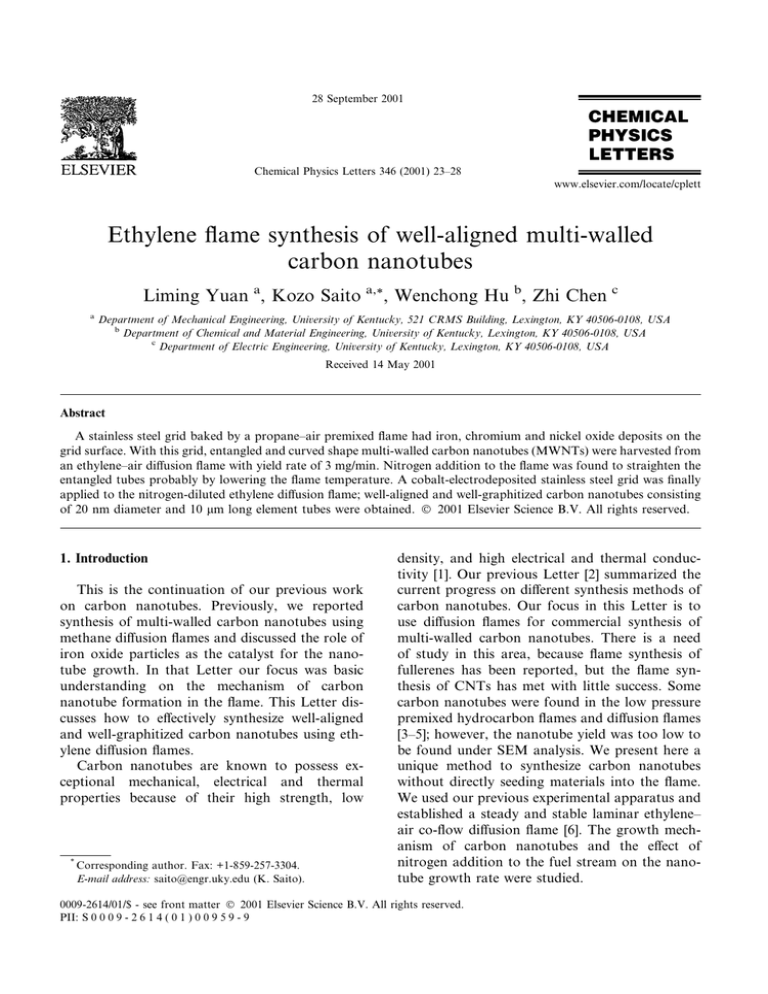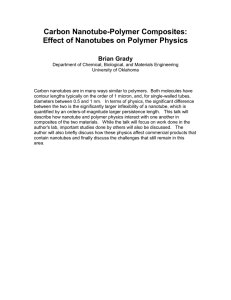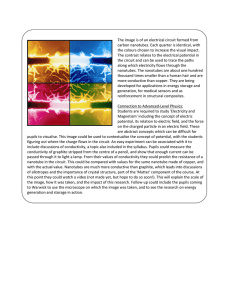
28 September 2001
Chemical Physics Letters 346 (2001) 23±28
www.elsevier.com/locate/cplett
Ethylene ¯ame synthesis of well-aligned multi-walled
carbon nanotubes
Liming Yuan a, Kozo Saito a,*, Wenchong Hu b, Zhi Chen c
a
Department of Mechanical Engineering, University of Kentucky, 521 CRMS Building, Lexington, KY 40506-0108, USA
b
Department of Chemical and Material Engineering, University of Kentucky, Lexington, KY 40506-0108, USA
c
Department of Electric Engineering, University of Kentucky, Lexington, KY 40506-0108, USA
Received 14 May 2001
Abstract
A stainless steel grid baked by a propane±air premixed ¯ame had iron, chromium and nickel oxide deposits on the
grid surface. With this grid, entangled and curved shape multi-walled carbon nanotubes (MWNTs) were harvested from
an ethylene±air diusion ¯ame with yield rate of 3 mg/min. Nitrogen addition to the ¯ame was found to straighten the
entangled tubes probably by lowering the ¯ame temperature. A cobalt-electrodeposited stainless steel grid was ®nally
applied to the nitrogen-diluted ethylene diusion ¯ame; well-aligned and well-graphitized carbon nanotubes consisting
of 20 nm diameter and 10 lm long element tubes were obtained. Ó 2001 Elsevier Science B.V. All rights reserved.
1. Introduction
This is the continuation of our previous work
on carbon nanotubes. Previously, we reported
synthesis of multi-walled carbon nanotubes using
methane diusion ¯ames and discussed the role of
iron oxide particles as the catalyst for the nanotube growth. In that Letter our focus was basic
understanding on the mechanism of carbon
nanotube formation in the ¯ame. This Letter discusses how to eectively synthesize well-aligned
and well-graphitized carbon nanotubes using ethylene diusion ¯ames.
Carbon nanotubes are known to possess exceptional mechanical, electrical and thermal
properties because of their high strength, low
*
Corresponding author. Fax: +1-859-257-3304.
E-mail address: saito@engr.uky.edu (K. Saito).
density, and high electrical and thermal conductivity [1]. Our previous Letter [2] summarized the
current progress on dierent synthesis methods of
carbon nanotubes. Our focus in this Letter is to
use diusion ¯ames for commercial synthesis of
multi-walled carbon nanotubes. There is a need
of study in this area, because ¯ame synthesis of
fullerenes has been reported, but the ¯ame synthesis of CNTs has met with little success. Some
carbon nanotubes were found in the low pressure
premixed hydrocarbon ¯ames and diusion ¯ames
[3±5]; however, the nanotube yield was too low to
be found under SEM analysis. We present here a
unique method to synthesize carbon nanotubes
without directly seeding materials into the ¯ame.
We used our previous experimental apparatus and
established a steady and stable laminar ethylene±
air co-¯ow diusion ¯ame [6]. The growth mechanism of carbon nanotubes and the eect of
nitrogen addition to the fuel stream on the nanotube growth rate were studied.
0009-2614/01/$ - see front matter Ó 2001 Elsevier Science B.V. All rights reserved.
PII: S 0 0 0 9 - 2 6 1 4 ( 0 1 ) 0 0 9 5 9 - 9
24
L. Yuan et al. / Chemical Physics Letters 346 (2001) 23±28
2. Experimental
A laminar ethylene±air co-¯ow diusion ¯ame
was used to synthesize MWNTs. A schematic diagram of the experimental apparatus was shown in
our previous Letter [2]. Ethylene (99.5% purity)
was issued from a 1.1 cm diameter stainless steel
tube, which was surrounded by a 5 cm diameter
tube through which air ¯owed. With the average
linear fuel ¯ow rate of 4.7 cm/s and the average
linear air¯ow rate of 63 cm/s, a steady and stable
laminar ¯ame with a visible ¯ame height of 33 mm
was established on the burner port. All syntheses
were performed at normal atmospheric pressure. A
stainless steel grid (type 304) was used as the
substrate for the nanotube growth. The material
deposited on the wire was examined directly by
SEM (Hitachi S900, 3 kV). The deposit material
was dispersed in ethanol using a mild sonication.
Drops of the dispersion were placed on the copper
TEM grids and dried for TEM analysis (JEOL
JEM-2000-FX, 200 kV). TEM±EDX (energy dispersive X-ray) analysis was performed using an
Oxford INCA detector attached to the TEM. A
high-resolution TEM (JEOL 2010F, 200 kV) was
also employed to study the microstructure of carbon nanotubes.
3. Results and discussion
When the stainless steel grid was inserted into
the ¯ame 4 mm above the exit port without any
pre-treatment, and kept there for 10 min, some
black material deposited on the grid. There were
no nanotubes found under SEM analysis; however
some MWNTs were found under TEM analysis.
Most of the deposit material was amorphous soot
particles. This indicates that the metal oxide (iron
oxide and nickel oxide) particles formed on the
metal surface were not suitable as the catalyst
particles for carbon nanotube growth. In our
previous study, a Ni±Cr wire was placed in the
laminar methane diusion ¯ame for 10 min; the
formed nickel oxide particles were favorable for
the carbon nanotube growth [2]. The formation of
iron oxide was faster than that of nickel oxide; the
morphology of iron oxide layer on the metal sur-
face was dierent from that of nickel oxide. When
the Ni±Cr wire was placed in the ethylene ¯ame for
10 min, some carbon ®bers loaded with amorphous carbon particles were produced, indicating
the oxidation process in the ethylene ¯ame to be
somewhat dierent from the methane ¯ame. To
synthesize a pure form of carbon nanotubes, we
pre-oxidized the stainless steel grid using a lean
premixed propane ¯ame for about 5 s. SEM and
TEM analyses on the pre-oxidized grid showed
that a layer of several dierent types of particles
whose diameter ranged from 10 to 200 nm was
formed. The TEM±EDX spectra identi®ed these
particles to be iron, chromium, nickel, oxygen and
carbon. We believe that most of the metal elements
exist in metal oxide form, some as metal carbide.
When the grid was placed in the ethylene ¯ame for
10 min, a layer of dark gray deposit material that
was identi®ed by SEM as a bundle of entangled
and curved MWNTs with their diameter of 10±60
nm and some carbon ®bers with a diameter larger
than 100 nm (Fig. 1). The length of nanotubes is at
least several lm and the growth rate of gray material was more than 3 mg/min.
3.1. The sampling time
Several dierent sampling times ranging from 1
to 10 min were applied to see whether or not the
morphology of carbon nanotube changes. With an
increase of sampling time, the production rate of
carbon ®bers increased, probably due to a continuous deposition of pyrolytic carbon onto the
carbon nanotubes [7]. We found that the length of
carbon nanotubes reached the maximum length 2±
5 lm within less than 1 min, while with an increase
of the sampling time beyond 1 min, the thickness
of nanotube walls increased but the length remained the same. We also found after the deposition of pyrolytic carbon on the nanotube surface,
the nanotube grew mainly in thickness, but not
length, and eventually became a solid nano®ber.
With a 10 min sampling time, the nanotube diameter increased to 20±60 nm, but the length remained the same probably due to the formation of
pyrolytic carbon on the nanotube surface, a different result from our previous methane ¯ame
synthesis, where pyrolysis products were stable
L. Yuan et al. / Chemical Physics Letters 346 (2001) 23±28
25
Fig. 1. SEM (a) and TEM (b) images of carbon nanotubes synthesized from an ethylene diusion-¯ame using a stainless steel sampling
grid coated with catalyst particles created by a premixed propane ¯ame (magni®cation is shown in each ®gure).
and the pyrolytic carbon concentration was much
lower than ethylene ¯ames.
3.2. The eect of nitrogen addition
Our ethylene ¯ame was diluted with nitrogen,
C2 H4 =N2 0:25, to change the temperature of
the ¯ame. The stainless steel grid was pre-oxidized with a premixed propane ¯ame, and was
placed for 10 min in the ethylene ¯ame at the
same position where we obtained the Fig. 1
result. Fig. 2 shows SEM and TEM images of the
carbon nanotubes that contain few carbon ®bers.
The ¯ame temperature at the sampling location in
this diluted ethylene ¯ame is 1244 °C, while the
corresponding temperature for an undiluted
ethylene ¯ame is 1547 °C. Thus, the observed
signi®cant reduction of carbon ®bers may be due
to lower temperature and lower fuel concentration conditions. The lower temperature that can
reduce the pyrolysis rate of hydrocarbon products
in the ¯ame may have something to do with an
increase of nanotube formation but may suppress
the growth of carbon ®bers probably due to the
lower chemical reaction rate of the hydrocarbon
pyrolysis reaction. The nitrogen dilution eect
may also have something to do with the creation
of the nearly same diameter nanotubes, probably
by limiting the growth of the nanotube wall
thickness due to the limited chemical species and
the lower chemical reaction rate.
3.3. Cobalt-coated grid
The oxidized stainless steel grid produced entangled and curved multi-walled carbon nanotubes. To obtain straight and uniform diameter
nanotubes, cobalt particles were electrodeposited
on to the stainless steel surface by a two-probe dc
method in 5 wt% CoSO4 7H2 O and 2 wt% H3 BO3
solution for 5 min. This cobalt-coated grid was
placed for 5 min at the same location as the Figs. 1
and 2 result. Fig. 3 presents SEM and TEM images of well aligned and nearly uniform diameter
carbon nanotubes obtained by the cobalt-coated
grid. Interestingly, some nanotubes bend down
(Fig. 3), while others are straight (Fig. 4), although
both nanotubes were produced by the same cobalt-
26
L. Yuan et al. / Chemical Physics Letters 346 (2001) 23±28
Fig. 2. SEM (a) and TEM (b) images of carbon nanotubes synthesized from a nitrogen-diluted ethylene diusion-¯ame using a
stainless steel sampling grid coated with catalyst particles created by a premixed propane ¯ame (magni®cation is shown in each ®gure).
(a)
(b)
Fig. 3. SEM (a) and TEM (b) images of carbon nanotubes synthesized from an ethylene diusion-¯ame using a cobalt-coated stainless
steel grid (magni®cation is shown in each ®gure).
coated grid at the same ¯ame location. We noticed
spacing between each nanotube is dierent: nanotubes in Fig. 3 are more packed than in Fig. 4,
suggesting that the mechanical strength required
for each nanotube to shoot up straight may be
weakened by friction between nanotubes.
L. Yuan et al. / Chemical Physics Letters 346 (2001) 23±28
Fig. 4. Vertically oriented, well-aligned nanotubes synthesized
by a cobalt-coated stainless steel grid.
3.4. The growth mechanism of MWNTs
The growth mechanism was investigated by
examining the SEM, TEM images and TEM±
EDX spectra. In the SEM images, some particles
were found attached to the one end of the nanotubes. These particles were not well separated,
and were closely connected to each other. The
TEM images con®rmed that very few particles
were encapsulated inside the nanotubes. The nanotubes were probably grown from some smaller
particles, and entangled with each other. The
nanotubes seemed to grow mainly by a root
growth that was described by Baker [8]. The
TEM±EDS (energy dispersion spectrum) showed
that these particles were mainly iron oxide, although some are nickel oxide, con®rming our
examination on the oxidized metal surface before
nanotube growth. These particles acted as catalyst particles for nanotube growth. The interaction between metal surface and metal oxide
particles seems very weak. SEM images showed
that some particle block was detached from the
surface because of the nanotube growth. But the
interaction between these particles may be strong,
because even after mild sonication, some particles
are still connected to each other on the TEM
27
images. Experimental results showed that the diameters of carbon nanotubes were well correlated
with the diameters of catalyst particles [9]. The
smaller catalyst particles generated smaller nanotubes. Because the metal oxide particles were
strongly bonded to each other, no catalyst particles could be pushed up to encapsulate nanotubes.
For the nanotube growth out of cobalt particles, TEM±EDX spectra con®rm the existence of
cobalt and oxygen. Some of the cobalt may be
oxidized in the ¯ame. Fig. 3a SEM image of carbon nanotube synthesized from cobalt particles
shows no obvious particles or block of particles
attached to the tubes that were observed in the
propane-oxidized grid sampling. Fig. 3b TEM
image also displays no catalyst particles encapsulated inside the nanotubes indicating a strong
bond between the cobalt catalyst particles and the
metal surface. Fig. 5 high-resolution TEM image
shows that the nanotubes synthesized from our
ethylene ¯ame have been well graphitized.
The production rate of MWNT is very sensitive
to the sampling location. With an increase of the
sampling location above the current location, the
concentration of pyrolyzed hydrocarbon products
increased. Some of the pyrolyzed hydrocarbon
products can be decomposed by catalyst particles,
but the rest will produce amorphous carbons, a
contaminant for catalyst particles.
Fig. 5. HRTEM image of a typical nanotube synthesized by a
cobalt-coated stainless steel grid (scale bar: 5 nm).
28
L. Yuan et al. / Chemical Physics Letters 346 (2001) 23±28
4. Conclusions
With a stainless steel grid as the substrate and
oxidized by a premixed propane ¯ame, entangled
nanotubes with diameters ranging from 10 to 60
nm were formed from a laminar ethylene±air diffusion ¯ame. The yield rate of the nanotubes from
our current laboratory apparatus was approximately 3 mg/min. Well-aligned and well-graphitized multi-walled carbon nanotubes consisting of
nearly uniform diameter nanotubes were synthesized from a nitrogen diluted laminar ethylene±air
diusion ¯ame with a cobalt-electrodeposited
stainless steel grid.
Acknowledgements
This study was sponsored by National Science
Foundation under the MRSEC program (DMR-
9809686). We would like to acknowledge the
valuable comments from Professor F.A. Williams
and Professor A.S. Gordon. We also acknowledge
Bob Gregory for his editing work.
References
[1] T.W. Ebbesen, Carbon Nanotubes: Preparation and Properties, CRC Press, Boca Raton, FL, 1997.
[2] L. Yuan, K. Saito, C. Pan, F.A. Williams, A.S. Gordon,
Chem. Phys. Lett. 340 (2001) 237.
[3] R.L. Vander Wal, T.M. Ticich, V.E. Curtis, Chem. Phys.
Lett. 323 (2000) 217.
[4] J.B. Howard, K. Das Chowdhury, J.B. Vander Sande,
Nature 370 (1994) 603.
[5] H. Richter et al., Carbon 34 (1996) 427.
[6] K. Saito, A.S. Gordon, F.A. Williams, W.F. Stickle,
Combust. Sci. Technol. 80 (1991) 103.
[7] M. Endo et al., Carbon 33 (1995) 873.
[8] R.T. Baker, Carbon 27 (1989) 315.
[9] W.Z. Li et al., Chem. Phys. Lett. 335 (2001) 141.








